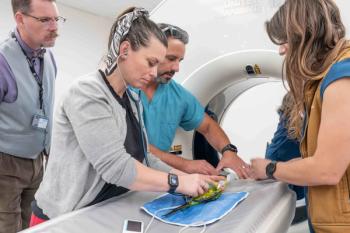
Research Update: How well does abdominal ultrasonographic evaluation guide surgeons?
In this retrospective study of 100 cases from a veterinary college, preoperative abdominal ultrasonography and exploratory laparotomy findings were reviewed to determine agreement and discrepancy rates and identify lesions likely to be missed by ultrasonography.
In this retrospective study of 100 cases from a veterinary college, preoperative abdominal ultrasonography and exploratory laparotomy findings were reviewed to determine agreement and discrepancy rates and identify lesions likely to be missed by ultrasonography. Imaging was performed by one of three experienced radiologists or by residents working under their direct supervision.
Nineteen cats and 81 dogs were included in the study, 47 of which were medium-sized dogs (10 to 27 kg). The results of the imaging and the surgery were classified according to anatomical location and gross pathologic features. Additionally, surgical findings were categorized as primary (main lesion) or secondary (other related) lesions.
The most common primary surgical findings were splenic or liver masses (30 cases), peritonitis (28 cases), and intestinal obstruction (14 cases). The sensitivities of ultrasonography for detecting these conditions were 63%, 89%, and 64%. No apparent relationship was detected between patient body size and the sensitivity of ultrasonography. A major discrepancy was observed between ultrasonography and identification of the main surgical lesion in 25% of the cases. Gastrointestinal ulcerations, perforations, and ruptures were the surgical findings most frequently missed by preoperative imaging. There was also a trend for organomegaly to be missed by ultrasonography. In 64% of the cases, the imaging and surgical reports agreed. The authors concluded that preoperative ultrasonography was useful.
COMMENTARY
Abdominal ultrasonography is a widely used noninvasive diagnostic modality, especially in ill animals requiring preoperative evaluation. The authors cite various studies in animals that have documented the sensitivity of ultrasonography in evaluating specific conditions (carcinomatosis and hepatobiliary disease) or presenting clinical signs such as hemoperitoneum after blunt trauma. These clinicians and residents had a success rate of either 64% (agreement with surgeons) or 75% (identification of primary lesion). It is worthwhile to note that body size did not affect the sensitivity of ultrasonography. However, morbid conditions affecting the integrity of the gastrointestinal tract were missed.
Pastore GE, Lamb CR, Lipscomb V. Comparison of the results of abdominal ultrasonography and exploratory laparotomy in the dog and cat. J Am Anim Hosp Assoc 2007;43(5):264-269.
The information in "Research Updates" was provided by Veterinary Medicine Editorial Advisory Board member Joseph Harari, MS, DVM, DACVS, Veterinary Surgical Specialists, 21 E. Mission Ave., Spokane, WA 99202.
Joseph Harari
Newsletter
From exam room tips to practice management insights, get trusted veterinary news delivered straight to your inbox—subscribe to dvm360.






